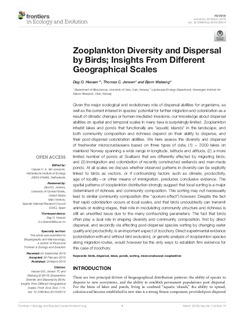Zooplankton diversity and dispersal by birds; Insights from different geographical scales
Peer reviewed, Journal article

Åpne
Permanent lenke
http://hdl.handle.net/11250/2590811Utgivelsesdato
2019Metadata
Vis full innførselSamlinger
- Scientific publications [1392]
Originalversjon
10.3389/fevo.2019.00074Sammendrag
Given the major ecological and evolutionary role of dispersal abilities for organisms, as
well as the current interest in species’ potential for further migration and colonization as a
result of climatic changes or human-mediated invasions, our knowledge about dispersal
abilities on spatial and temporal scales in many taxa is surprisingly limited. Zooplankton
inhabit lakes and ponds that functionally are “aquatic islands” in the landscape, and
both community composition and richness depend on their ability to disperse, and
their post-dispersal colonization abilities. We here assess the diversity and dispersal
of freshwater microcrustaceans based on three types of data; (1) > 2000 lakes on
mainland Norway spanning a wide range in longitude, latitude and altitude, (2) a more
limited number of ponds at Svalbard that are differently affected by migrating birds,
and (3) immigration and colonization of recently constructed wetlands and man-made
ponds. At all scales we discuss whether observed patterns in diversity can be explicitly
linked to birds as vectors, or if confounding factors such as climate, productivity,
age of locality—or other means of immigration, precludes conclusive evidence. The
spatial patterns of zooplankton distribution strongly suggest that local sorting is a major
determinant of richness and community composition. This sorting may not necessarily
lead to similar community composition (the “quorum effect”) however. Despite the fact
that rapid colonization occurs at local scales, and that birds undoubtedly can transmit
animals or resting stages, their role in modulating community structure and richness is
still an unsettled issue due to the many confounding parameters. The fact that birds
often play a dual role in shaping diversity and community composition, first by direct
dispersal, and secondly via affecting post-dispersal species sorting by changing water
quality and productivity, is an important aspect of zoochory. Direct experimental evidence
(colonization with and without bird exclusion), or genetic analysis of zooplankton species
along migration routes, would however be the only ways to establish firm evidence for
this case of zoochory.
